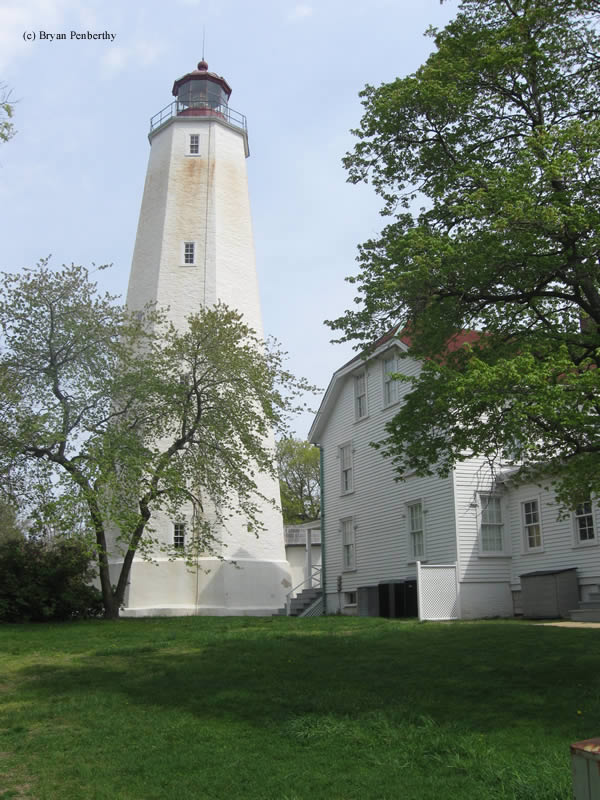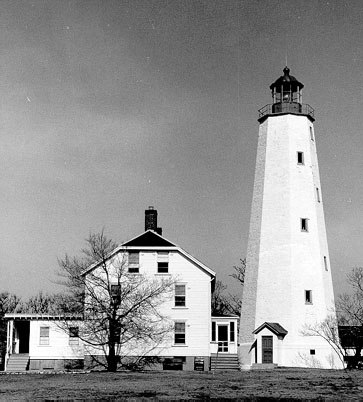Sandy Hook Lighthouse
Sandy Hook, New Jersey - 1764 (1764**)

History of the Sandy Hook Lighthouse
Posted/Updated by Bryan Penberthy on 2011-03-20.
For most ships approaching New York Bay, the first landfall they see if the Highlands of New Jersey. However, a major navigational obstacle stands in the way in the form of Sandy Hook, a narrow spit of land extending some four miles out into the shipping channel. Due to the numerous shipwrecks that took place on the shoals just off Sandy Hook, and fearing the loss of commerce to better marked ports, such as Boston to the north and Philadelphia to the south, New York merchants felt compelled to act swiftly. So, in 1761, forty three New York merchants petitioned the Colonial Assembly of New York for the creation of a lighthouse on Sandy Hook to mark a safe passage into Lower New York Bay.
 Sandy Hook Lighthouse (Courtesy Coast Guard)
Sandy Hook Lighthouse (Courtesy Coast Guard)
An act was put in place on May 19, 1761 by the New York Assembly whereby a lottery would be used to raise more for the lighthouse at Sandy Hook. The lottery was to raise £3000 by way of 10,000 tickets costing 40 shillings each, with 1684 of them being winning tickets with 15% deducted. The drawing took place on September 21, 1761 with the winning numbers appearing in the October 5, 1761 edition of the New York Mercury.
The lottery didn't raise nearly enough money required for the construction of the lighthouse. Instead, the £750 that was raised went toward the purchase of a four acre tract on Sandy Hook, with the land purchased from Robert and Esek Hartshorne on May 16, 1762.
The Legislature of the Colony of New York passed a law in their December 1762 session allowing a two more lotteries to take place. Again, with the same stipulations as before, 10,000 tickets at 40 shillings each, with 1684 winning tickets, the second drawing was held June 14, 1763, and the third drawing was held October 29, 1763. With the money raised from the subsequent lotteries, construction of the tower could resume.
The rubblestone tower, constructed by Isaac Conro of New York City, when completed stood 500 feet from the tip of Sandy Hook. At this time, many people referred to the lighthouse, the "New York Lighthouse" and was first lit June 11, 1764. The June 18, 1764 edition of the New York Mercury had this description of the tower:
"On Monday Evening last, the NEW-YORK LIGHT HOUSE erected at Sandy Hook was lighted for the first Time. The House is of an Octogonal Figure, having eight equal Sides; the diameter at the Base, 29 Feet; and at the Top of the Wall, 15 Feet. The lanthorn is 7 Feet high; the Circumference 33 feet. The whole Constrcution of the Lanthorn is Iron; the Top covered with Copper. There are 48 Oil Blazes. The Building from the Surface is Nine Stories; the whole from Bottom to top, 103 Feet."
The lottery paid for the construction of the lighthouse, however, the keeper's salary and the ongoing maintenance of the tower would be paid for by a tonnage tax of three pence per ton of ships coming into New York Harbor. This allowed the coverage of expenses, and even provided a little profit.
With the start of the American Revolution, The Congress of New York authorized the disabling of the Sandy Hook Lighthouse before the impending arrival of the British fleet. Major William Malcolm received orders on March 6, 1776 to remove the lighting apparatus and oil from the Sandy Hook Lighthouse so that if it should fall into the enemy's hands, it would be useless. Within several months, the British would have the lighthouse repaired, and enabled.
With the Sandy Hook Lighthouse under British Control, Lieutenant Colonel Benjamin Tupper led an attack on June 1, 1776 attempting to destroy the tower. After taking cannon fire for over an hour, the damaged tower still stood. In the face of increased resistance, Tupper was forced to retreat. The British would retain control of the lighthouse for most of the war.
In 1789, all lighthouses in existence were placed under control of the Treasury of the United States with an act stating:
"the necessary support, maintenance and repairs of all lighthouses beacons, buoys, and public piers erected, placed or sunk before the passing of this act, at the entrance of, or within any bay, inlet, harbor or port of the United States, for rendering the navigation thereof easy and safe, shall be defrayed out of the treasury of the United States."
In 1817, two other beacons were erected on Sandy Hook, called the Sandy Hook East and the Sand Hook West beacons, with the keeper being responsible for all three beacons. An inspection of 1838 reports of the poor construction and lighting apparatus of the two smaller beacons, so by 1842, they would be replaced. The keeper of the Sandy Hook Lighthouse was authorized to hire help at this time, but it would be 1857 before three assistants were assigned to Sandy Hook. The west and east beacons were again rebuilt in 1855, and 1856 respectively. Also in 1856, the lighting apparatus was swapped out in favor of a third order Fresnel lens.
The station has gone through several upgrades over the years. The East Beacon was the first reported use of a steam driven fog signal, having been installed in 1867, and then upgraded again in 1883. A new expanded keeper's house was constructed in 1883, which is the dwelling that stands today, making it the third documented dwelling to be used on site.
The lighting apparatus has been upgraded over the years as well. In 1764, it was forty eight oil blazes as documented. In 1776, it was listed as having eight copper lamps. 1827 saw installation of the Winslow Lewis patented lamps. Argand lamps were installed in 1842. A third order Fresnel was installed in 1856. Incandescent electric lights were in use from 1889 to 1903. In 1903, kerosene lamps were swapped in due to cost, however, in 1925, electric was supplied to the site.
Although erosion has affected many New Jersey lighthouses over the years, the Sandy Hook Lighthouse is not one of them. When the lighthouse was built in 1764, it was 500 feet from the water; today it stands about one and a half miles from the water. It seems the ocean tides have been pulling sand from other areas and depositing at the end of the spit. The lighthouse still displays its light each night, the same as it has since 1764.
Reference:
- New Jersey Lighthouse Society website.
- America's Lighthouses - An Illustrated History, Francis Ross Holland, Jr., 1972.
- The Hudson River Guidebook, Arthur G. Adams, 1996.
- Vacationing on the Jersey Shore: Guide to the Beach Resorts, Past and Present, Charles A. Stansfield, Jr., 2004.
- Lighthouses & Keepers - The U.S. Lighthouse Service and its Legacy, Dennis L. Noble, 1997.
- U.S. Coast Guard website.
Directions: From Route 36 in Highlands, exit at Ocean Ave. heading north into Sandy Hook National Park. This will change names to Hartshorne Drive. Follow this north to McGruder Road and then to Hudson Drive.
Access: The lighthouse is owned by the National Park Service. Grounds open. Tower is open during during in season.
View more Sandy Hook Lighthouse picturesTower Height: 103.00'
Focal Plane: 88'
Active Aid to Navigation: Yes
*Latitude: 40.46200 N
*Longitude: -74.00200 W
See this lighthouse on Google Maps.
